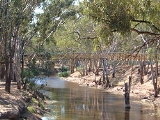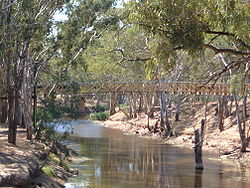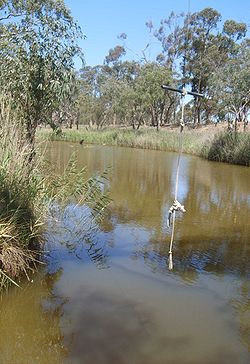
Avoca River
Encyclopedia


Australia
Australia , officially the Commonwealth of Australia, is a country in the Southern Hemisphere comprising the mainland of the Australian continent, the island of Tasmania, and numerous smaller islands in the Indian and Pacific Oceans. It is the world's sixth-largest country by total area...
. The river rises at the foot of Mount Lonarch in the Central Highlands near the small town of Amphitheatre
Amphitheatre, Victoria
Amphitheatre is a small town in Victoria, Australia. It is located on the Pyrenees Highway in the Pyrenees Shire, south-west of Avoca. At the 2006 census, Amphitheatre and the surrounding area had a population of 291....
, and flows north for 270 km through Avoca
Avoca, Victoria
Avoca is a town in the Central Highlands of Victoria, Australia, north west of Ballarat. It is one of two main towns in the Pyrenees Shire, the other being Beaufort to the south. At the 2006 census, Avoca had a population of 951.-Geography:...
, Charlton
Charlton, Victoria
Charlton "The Friendly River Town", is a town in Victoria, Australia. It is a small agricultural community straddling the Avoca River, located at the junction of the Calder Highway and Borung Highway and positioned in the last of the foothills of the Great Dividing Range...
and Quambatook
Quambatook, Victoria
Quambatook is a town in northern Victoria, Australia. The town is located on the Avoca River in the Shire of Gannawarra Local Government Area, from the state capital, Melbourne. At the 2006 census, Quambatook had a population of 253....
. Although the Avoca River Basin is part of the Murray-Darling Basin
Murray-Darling Basin
The Murray-Darling basin is a large geographical area in the interior of southeastern Australia, whose name is derived from its two major rivers, the Murray River and the Darling River. It drains one-seventh of the Australian land mass, and is currently by far the most significant agricultural...
, the Avoca does not empty into the Murray
Murray River
The Murray River is Australia's longest river. At in length, the Murray rises in the Australian Alps, draining the western side of Australia's highest mountains and, for most of its length, meanders across Australia's inland plains, forming the border between New South Wales and Victoria as it...
. Nowhere a large stream, it dwindles as it flows north, eventually terminating in the Kerang Lakes, a network of ephemeral swamps west of Kerang and about 20 km south of the Murray.
Although the Avoca has a substantial 14 000 square kilometres catchment area (the fifth largest in Victoria), most of that area is on the northern plains where rainfall averages only about 350 mm per year, and where there is little runoff as the terrain is very flat. The mean annual runnoff of 137 GL/year accounts for only 0.67% of Victoria's runoff. Most of the water flowing in the Avoca originates in the narrow upper portion of the catchment area, where rainfall averages about 600 mm per year, most of it falling in the winter and spring.
Of all the Victorian rivers in the Murray-Darling Basin, the Avoca is the most variable. The average annual flow is 85 000 ML, however recorded actual flows have varied from almost five times the average figure in very wet years to 0.5% of the average in drought years. It is normal for the Avoca to stop flowing for weeks or months at a time during summer and autumn.
Although it is the only river of significance in the area, the Avoca has had no major water storages constructed on it, merely six weirs of only local significance.
It is little used for irrigation as during the peak demand period (summer and autumn) it is often not flowing at all. During low flow periods Avoca River water is usually too saline to water crops with, but can still provide drinking water for sheep and cattle.

